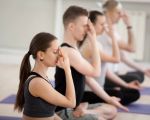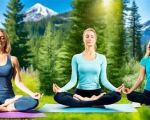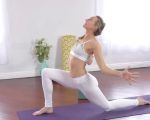- why-yoga-works-for-anxiety-and-emotional-balance
- how-breath-and-movement-help-calm-the-mind
- specific-yoga-poses-to-calm-the-mind-and-body
- real-story-how-kara-used-yoga-to-manage-panic-attacks
- find-practice-guidance-on-free-yoga-links
1. Why Yoga Works for Anxiety and Emotional Balance
The link between mind and body is real—and powerful. That’s why yoga for anxiety isn’t just a wellness trend; it's a proven tool for emotional regulation. By combining breath control, mindful movement, and meditative awareness, yoga helps calm the nervous system and shift us from fight-or-flight mode into rest-and-digest.
Scientific studies show that regular yoga practice lowers cortisol levels and activates the parasympathetic nervous system. This means reduced stress, better sleep, and improved emotional resilience. For those battling anxiety, this isn’t just helpful—it’s life-changing.
2. How Breath and Movement Help Calm the Mind
2.1 The Science Behind It
Breath-focused yoga practices—like alternate nostril breathing or deep belly breathing—signal safety to the brain. They slow the heart rate, reduce muscle tension, and quiet the mind’s endless chatter. This makes it easier to be present rather than spiraling into anxious thought patterns.
2.2 Movement as Meditation
When you synchronize movement with breath, as in Vinyasa or Hatha yoga, your mind focuses naturally. You stop anticipating the future or rehashing the past. That state of “flow” offers a powerful reprieve from anxious loops.
2.3 Stillness Has Power Too
In Yin or Restorative yoga, long-held passive poses support nervous system reset. This stillness invites emotional release, grounding, and deep calm—especially when supported with blankets, bolsters, or dim lighting.
3. Specific Yoga Poses to Calm the Mind and Body
3.1 Child’s Pose (Balasana)
A go-to for calming overwhelm, Child’s Pose grounds your energy. Folding forward brings the head to the floor, signaling surrender and safety to the brain. Deepen the effect by breathing slowly into the back body.
3.2 Legs-Up-The-Wall (Viparita Karani)
This gentle inversion reverses blood flow and soothes the nervous system. It’s especially useful before sleep or after a stressful day. Let gravity do the work while you focus on long, slow exhales.
3.3 Seated Forward Fold (Paschimottanasana)
Forward bends are naturally calming. This pose stretches the spine and hamstrings while encouraging inward focus. It invites stillness—both physically and mentally.
3.4 Supine Twist (Supta Matsyendrasana)
Twists help release tension from the spine and detoxify stress hormones. When done slowly, they can stimulate digestion and emotional release—common areas impacted by anxiety.
4. Real Story: How Kara Used Yoga to Manage Panic Attacks
Kara, a 29-year-old UX designer from Austin, began practicing yoga after a panic attack left her unable to drive to work. “I started with 10 minutes of breathwork and Child’s Pose every morning,” she recalls. Within weeks, her episodes became less frequent and less intense.
What helped Kara wasn’t just the movement—it was the routine and emotional self-connection yoga created. “I finally felt like I had a way to respond when anxiety hit, instead of just bracing for it,” she said. Her journey illustrates how even small, consistent practice can bring big change.
5. Find Practice Guidance on Free Yoga Links
Whether you're completely new to yoga or already know your way around a mat, finding the right guidance is key. That’s where Free Yoga Links comes in. From beginner-friendly sequences focused on poses to calm the mind to expert advice on building your own calming routines, the platform offers tools tailored for real-life anxiety relief.
If you’re ready to take control of your inner world, one breath and one pose at a time, explore the curated practices at Free Yoga Links. You might be surprised how quickly yoga becomes a daily lifeline—one that fits in your home, your schedule, and your mental health journey.








